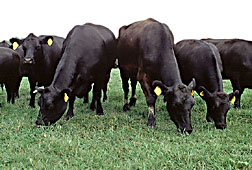This page has been archived and is being provided for reference purposes only. The page is no longer being updated, and therefore, links on the page may be invalid.
|
From Dirt to Diamonds
By Sharon DurhamJuly 29, 2005
Carbon stored in soil during the first five years of bermudagrass management was two to three times greater when the grass was grazed than when it was harvested for hay or left unharvested, according to Agricultural Research Service (ARS) scientists.
Carbon dioxide in air is important for life on earth, but its rapidly rising concentration is cause for concern, because of its contribution to the greenhouse effect and potential global warming. Maintaining more carbon in soil means less of it escapes into the atmosphere.
Ecologist Alan Franzluebbers and animal scientist John Stuedemann of ARS found that cattle grazing on forage grasses could help improve carbon storage in soil. In studies at ARS' J. Phil Campbell, Sr. Natural Resource Conservation Center in Watkinsville, Ga., they found that adding cattle grazing to a crop rotation system can be beneficial by enriching the soil with carbon and other nutrients. Also, income could be generated from the cattle.
In Georgia, plowing and other practices have resulted in lost top soil. Fortunately, permanent pasture now accounts for about 18 percent of land area in the southeastern states, compared to 20 percent for cropland. Converting land to permanent pasture has significantly reduced soil erosion.
In most instances, crop farming and cattle farming are separate operations. Franzluebbers and Stuedemann envision a system where calves could be raised on pasture in rotation with other crops like corn or wheat. The type of crop would determine when grazing would occur.
According to the researchers, putting as little as 10 percent of existing cropland in rotation with grazing could significantly reduce costs, due to lower inputs such as herbicides, and generate additional income from the livestock. The next step for the researchers is looking at long term integration of annual crops with perennial grasses.
ARS is the U.S. Department of Agriculture's chief scientific research agency.

